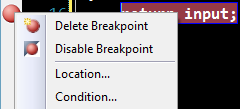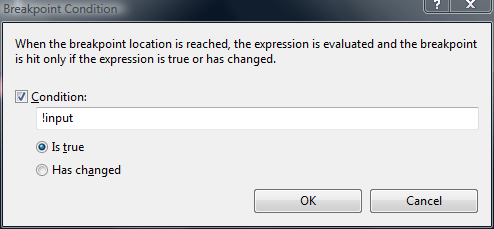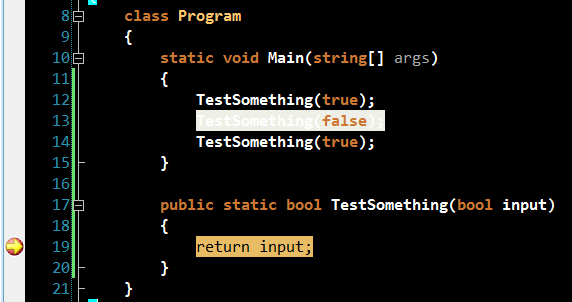Daniel Hoelbling-Inzko talks about programming
Conditional breakpoints in Visual Studio
Sometimes you do something and you never really think about what you’re doing.
Like the following code:
public bool TestSomething(bool input)
{
if (input == true)
{
return true;
}
else
{
return false;
}
}
It’s so obvious, I never thought about what I was really doing there, let alone seen the mistake I made. I mean, without any knowledge about boolean evaluation you still should figure out how to get rid of the bracket porn and produce something like this:
public bool TestSomething(bool input)
{
if (input == true)
return true;
return false;
}
But that’s only syntactic, the whole statement itself is still silly. The whole == true is completely redundant because you already check a boolean condition to evaluate it to a boolean.
So it boils down to:
public bool TestSomething(bool input)
{
return input;
}
And that’s it. You just saved yourself 6 lines of code that where completely useless (and I guess the compiler is smart enough to optimize that anyway Update: actually, this does make a difference. The compiler can’t figure this out and will produce more IL code because of this).
But once I did this I felt I lack the ability to put a breakpoint on the return false statement. And I eventually may have thought about going back to solution #2. But then I found this little thing in Visual Studio that made my day (and all major IDEs have that, only they hide it well):
When you right click a breakpoint you can add a Condition to it, so it will only break when that condition is met. I did so, and voila:
Without having to degrade my code I still could break only when false was returned.
So when I ran it the first break was in the third call:
So, thank god for such great tools like Visual Studio and ReSharper (R# hinted to me that I was doing something stupid in the first place)!




